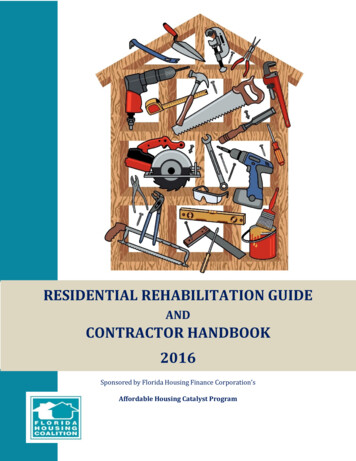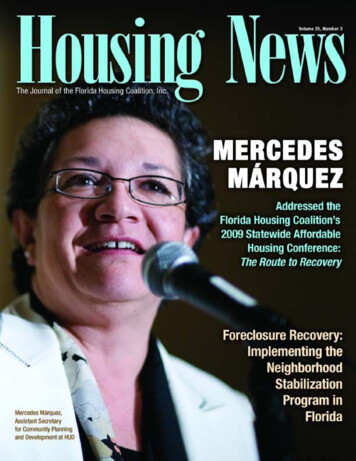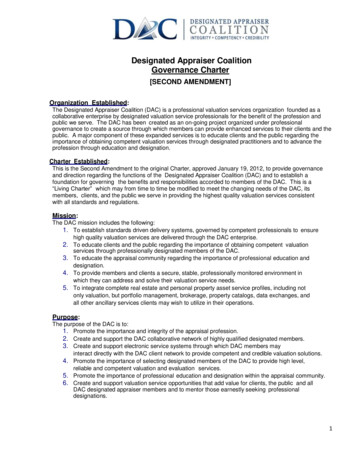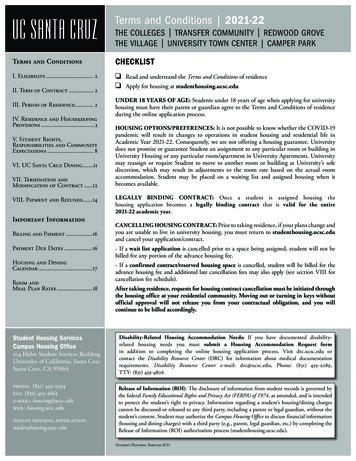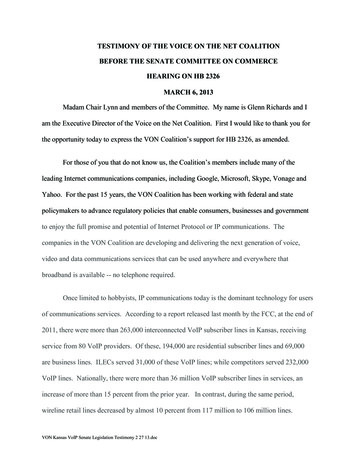
Transcription
EXECUTIVE COMMITTEEJeff Bagwell, CHAIRKeystone Challenge Fund, Inc.Annetta Jenkins, VICE CHAIRLocal Initiatives Support CorporationJaimie Ross, PRESIDENT1000 Friends of FloridaGregg Schwartz, TREASURERTampa Bay C.D.C.Sophia Sorolis, SECRETARYCity of St. PetersburgMelvin Philpot, PAST CHAIRProgress Energy FloridaMark Hendrickson, AT LARGEThe Hendrickson CompanyGeorge Romagnoli, AT LARGEPasco County Community DevelopmentRobert Von, AT LARGEMeridian Appraisal Group, Inc.BOARD OF DIRECTORSBob AnsleyOrlando Neighborhood Improvement Corp.Michelle BraunWachoviaEd BusanskyFirst Housing Development Corp. of FloridaJames “Jim” DyalAmerican Realty Development, LLC.Charles “Chuck” ElsesserFlorida Legal ServicesDenise FreedmanBank of AmericaWight GregerCity of JacksonvilleDan HorvathCommunity Enterprise Investments, Inc.Jack HumburgBoley Centers, Inc.Jeff KissKiss & CompanySteve KroppLCA Development II, Inc.Tei KucharskiFlorida Solar Energy CenterWilliam “Bill” O'DellShimberg Center for Affordable HousingEarl PfeifferFlorida Home Partnership Inc.Arden ShankNeighborhood Housing Servicesof South Florida, Inc.Happens to a Vision?4 WhatThe William E. Sadowski AffordableHousing Act6 Fund Housing in 20097 Scrap the Cap in 2009FINANCIAL SERVICESCOMMITTEEADVISORY COUNCILSTAFFADMINISTRATIONDebby Beck Operations & ConferenceManagerCharlene Chen Financial ManagerPam Davis Workshop CoordinatorStan Fitterman Chief Operating OfficerTECHNICAL ADVISORSAida Andujar South Florida OfficeLydia Beltrán South Florida OfficeMichael Chaney North Florida OfficeStan Fitterman Central Florida OfficeLisa Hoffmeyer South Florida OfficeEvelyn Rusciolelli Central Florida OfficeGladys Schneider Southwest Florida OfficeFLORIDA HOUSING COALITION, INC.,Phone: (850) 878-4219, Fax: (850) 942-6312,1367 E. Lafayette Street, Suite C, Tallahassee,FL 323012THE HOUSING NEWS NETWORKNew Single Family Homes in20 BuildingToday’s Environment?with the Florida Department22 Partneringof Elder Affairs24 Change Agents – From Charity to ImpactFlorida Housing Coalition Provides26 TheNSP Training and Technical AssistanceClaire RaleyWashington MutualDavid ChristianRegionsRuna SaundersNational CityDeana LewisSunTrust BankHelen Hough FeinbergRBC Capital Markets16 If SHIP Is Not Funded.Management and Affordable18 GrowthHousingLoses 625 Million of Federal8 FloridaFunds from Failure to Fund HousingEnforcement Community Fights29 CodeBack Against Abandoned PropertyNeglectHasn’t the Foreclosure Crisis Solved10 ButNeighborhood Stabilization Program:Florida’s Need for Affordable Housing?30 TheGoing Green in Acquisition and HousingRehabilitation12 Economic Benefits of Sadowski ActSHIP Clips32Florida’s Hurricane Housing Recovery14 Program (HHRP) Successes34 Coalition NewsThe Florida Housing Coalition is a nonprofit, statewide membership organization whose mission is to act as a catalyst to bring together housing advocatesand resources so that Floridians have a quality affordable home and suitable living environment. The Housing News Network is published by the FloridaHousing Coalition as a service to its members, housing professionals and others interested in affordable housing issues.Jaimie Ross, Editor. Email: info@flhousing.org, Web site: www.flhousing.org
FROM THE EDITORAffordable Housing is Key to Recoverynormous mortgage financingerrors have been made inFlorida – but not in affordablehousing. We can take pride inknowing that homebuyers and rentersliving in the housing produced withSadowski Act monies are not associated with toxic mortgages. The typicalSHIP assisted homebuyer receivedBy Jaimie Rosspre and post purchase counselingand a fixed rate 30 year amortizing loan. If SHIP assistedhomebuyers find themselves in foreclosure, the cause islikely to be job loss caused by the downturn in the construction industry or the recession in general.ELow and moderate income Floridians in foreclosure arethose not fortunate enough to have been served by Florida’sSHIP or bond programs for first time homebuyers. They mayhave been families who were advised by the local SHIPoffice to join the homebuyer club to clean up their credit sothat they could qualify for a conventional loan, but wereenticed by the alternative of easy money. They may havebeen families who could have been served by their localSHIP program, but funding had run out.This edition of the Journal speaks to the essential role thataffordable housing plays in Florida’s economic recovery.A series of articles from the national, state, and localperspective makes the case that the wisest and mostprudent action for Florida is to reap the economic benefitsfrom funding affordable housing programs; stop the loss ofmillions in federal funds; and nourish the current housinginfrastructure to ensure that we have the capacity torespond to natural disasters. This Journal also addressesthe erroneous notion that the downturn in the housingmarket and the oversupply of housing from the foreclosurecrisis resolves the affordable housing problem.Florida’s Hurricane Housing Recovery, an article authored bythe Shimberg Center, recounts the success of Florida’srecovery when a succession of devastating hurricanespounded Florida. If a hurricane were to hit Florida now, wewould have nothing close to the dollars needed to replicatethat success. And if the SHIP program is not funded in the2009 session, we will lose SHIP offices around the state,dismantling the infrastructure which we now have in placeto respond to future disasters.The majority of foreclosed housing stock is not within theaffordable range for low and moderate income homebuyers.But with the help of the federal Neighborhood StabilizationProgram (NSP), some of those that are in the affordablerange will provide new homeownership opportunities for lowand moderate income homebuyers, and other foreclosedhouses and apartments will provide rental opportunities forvery low and extremely low income Floridians. The articleson NSP: Going Green in Acquisition and HousingRehabilitation, Florida Housing Coalition NSP Training; andCode Enforcement outline the Florida Housing Coalition’swide-ranging work with foreclosure recovery.The American Recovery and Reinvestment Act and theAffordable Housing and Financial Stability Act just signedinto law by President Obama, will provide considerableassistance to Florida in averting an even greater andimminent crisis of homelessness; the fallout of the “ponzistate” described in the much talked about New Yorkerarticle by George Packer. But Florida can not rely on federalprograms to fix our affordable housing crisis. Indeed, it isfundamental that we restore our state housing trust fundprograms so that we can fully access the assistance that isnow available from the federal government.Although housing is by far the greatest economic engine inFlorida, we must learn from the recession and the unsustainable model of a state economy based almost entirely onpopulation growth and the housing construction needed tosupport that growth. Florida has intentionally decreasedrevenues through its tax repeals and exemptions for almosta decade. Adding insult to injury, cutting monies fromaffordable housing programs costs us billions. The 440million diverted from affordable housing in Fiscal Year2008-2009 ( 250 during the 2008 session and another 190 million diverted in the 2009 special session) will resultin the loss of 3.37 billion in economic activity/stimulus,33,880 jobs, at a value of 2.03 billion of badly neededlong-term quality affordable housing.To accelerate its economic recovery and avert the imminentincrease in homelessness caused by the recession, restoration of the Sadowski state and local housing trust funds isimperative: that means repealing the cap and appropriatingthe money dedicated for housing to housing.JAIMIE ROSS is the President of the Florida HousingCoalition and the Affordable Housing Director at 1000Friends of Florida.THE FLORIDA HOUSING COALITION3
What Happens to a Vision?The William E. Sadowski Affordable Housing ActThe Sadowski/Workforce HousingCoalition hosted a press conferenceand Housing Rally to emphasize theimportance of spending housingtrust fund money on housing.he passage of the WilliamsimultaneouslyE. Sadowski Affordablegiving cities andHousing Act in 1992 is acounties the opporperfect example of governmenttunity to addressmaking the right choice at the righttheir own unique housing needs and support innovatime. Among the earliest statetive new ideas. This too was new to the housinghousing trust funds in the country,trust fund world and has now assumed different vertheActsetahighbarforothersions in several states throughout the country.By Mary E. Brooksstates to replicate. As a consequence, it is particularly disturbing to think, thatThe rationale at the time the Act was passed waseven in critically troubling times, the State ofthat dedicating revenue from the documentaryFlorida would now fail to honor itsown stellar vision for providingEven in critically troubling times, the State of Floridahousing security and opportunitywould now fail to honor its own stellar vision for providingto the people of Florida.Thousing security and opportunity to the people of Florida.The Sadowski Act established aclever and unique structure bybuilding a state housing trust fund that addressesfundamental issues within the housing market while4THE HOUSING NEWS NETWORKstamp tax to a statewide housing trust fund connected the prosperity of the state to the need to maintain
What Happens to a Vision?safe, decent, and affordable housing for those in theworkforce and those unable to afford market ratehousing. This is now the most common revenuesource of the 38 states with state housing trust funds.Florida did indeed create the largest housing trustfund in the country—fitting, it would seem, for a statewith one of the most active real estate markets in thecountry. Yet even today a minimum wage worker earning an hourly wage of 6.79 must work 107 hours aweek to afford the fair market rent for a two-bedroomapartment. Regardless, the State decided to divertfunds dedicated to the trust funds and, in 2007, capthe amount of revenues the trust funds could receive.Not because Florida adequately met the housing needsof its residents, but because priority was given todoing other things with this money.Florida, through its housing trust funds, has builtan impressive infrastructure to support affordablehousing, increasing capacity and innovation in thefield. Housing opportunities were provided, neighborhoods were revitalized, families made more secureand allowed to prosper. And other state expenditureswere spared: families moving into safe and decenthousing experienced less critical health care emergencies; their children did better in school; perhapsgetting to work required less driving or even allowedtaking public transit; and laying roots in a communityincreased security for all. The return on the quality oflife is immeasurable.And now with the state facing severe housingconditions through record breaking foreclosures,displacements, and a growing homeless population,even more funds may be taken. This is not the time tocut our investment in affordable housing. Too manyfamilies are on the edge of financial collapse; toomany jobs are disappearing. Investing in affordablehousing is good fiscal policy. Housing trust funds create jobs; add to the tax base through property tax,sales tax, income tax and more. In fact, studies haveshown the return on investment in affordable housing isreal and substantial. And, indeed housing and homelessadvocates in Florida have done just this in their report,“The Economic Impact of the Sadowski Act.”One cannot help but wonder what happens to a vision.If the William E. Sadowski Affordable Housing Actwas a good idea in 1992, why is it mediocre now whenfamilies are struggling to find an affordable place tolive in one of the most devastating economic periodsof our country?Why would elected officials choose this year to renegeon funds committed to a model program, admiredthroughout the country—a program that addresses acritical need fundamental to the health of every community and that provides a concrete return on thestate’s investment. You got me. And I hope otherstates don’t look for Florida as a model, should theymake that choice.Mary E. Brooks, Director, Housing Trust Fund ProjectCenter for Community Changembrooks@communitychange.org*National Low Income Housing Coalition, “Out of Reach, 2008.” www.nlihc.org/oor/oor2008/.HOUSING DAY RALLY AT THE CAPITOLAPRIL 15 TH, 2009 AT 1:00PMON THE STEPS OF THE OLD CAPITOL FACING THE NEW CAPITOL-COME ALONE OR WITH A GROUPTHE FLORIDA HOUSING COALITION5
FUND HOUSING IN 2009TO ACCELERATE FLORIDA’S ECONOMYhe total appropriation forhousing in fiscal year2008-09 was 303 millionthe balance in the trust funds of 250 million was swept to generalrevenue. The revenue projection forFY 2009-2010 for the housing trustfunds is currently only 174 million.Tassist local governments in stabilizing neighborhoods through foreclosure recovery efforts. Our SHIPadministrators need down paymentand closing cost assistance fundsto ensure that those properties canbe sold to low and moderateincome homebuyers.The Sadowski Workforce HousingCoalition is calling upon theLegislature to appropriate the fullamount of housing trust fund dollarsto Florida’s housing programs.There is a tremendous opportunity for leveraging these federalresources.Housing is our greatest economic engine: when thatengine is fueled our economy thrives, when that engineis starved our economy dies. Right now we have tens ofthousands of homes, single family and condominiums inforeclosure. To put these homes back on the marketthey need to be acquired, rehabilitated, and resold.Every 16 of SAIL appropriations “buys” 84 of federalbonds and tax credits.We can accelerate Florida’s economic recovery byputting the housing industry to work on recoveringand rehabilitating foreclosed properties.Every one million dollars of state appropriationsfor housing produces: 4.62 million of housing, 7.66 million of economic activity, and 77 jobs.The federal Housing and Economic Recovery Act of2008 includes a supplemental CDBG appropriation to6THE HOUSING NEWS NETWORKThe Housing and Economic Recovery Act also includes 571 million of additional bond authority for Florida.This federal resource cannot be used without SAIL ordown-payment assistance from state appropriations.Hundreds of millions in federal resources will belost without adequate state funding.Too much housing stock? Doesn’t make sense todevelop new affordable housing? Not so. Singlefamily home prices are down—apartment rates are not.The deficit of affordable rental housing continues togrow. Many families losing homeownership are inneed of rentals. Florida’s workforce needs affordablerental housing.Land prices are down—it is an excellent time to acquireland or existing buildings to construct or preserve rentalhousing that will be affordable for 50 years to come.The downturn in the housing market will not lastforever; the units built or preserved now will providecritically needed housing for Florida’s low incomeworkforce long after the housing market recovers.
SCRAP THE CAP IN 2009he William E. SadowskiAffordable Housing Act(the Sadowski Act),enacted in 1992, created adedicated revenue source foraffordable housing by increasing the documentary stamptax paid on all real estatetransactions and dedicatingthat increase in taxes to the Stateand Local Housing Trust Funds.interests representing the housingindustry, business interest, lowincome advocates, state andlocal governments, faith basedorganizations, advocates forthe elderly, and growth management.TThis increase in doc stamp taxes wassupported by a diverse coalition of interests(the Sadowski Housing Coalition) including industrygroups like the Florida Home Builders Associationand the Florida Association of Realtors because themonies raised were to be placed in trust funds to beused exclusively for housing.The documentary stamp tax was the vehicle used tofund the state and local housing trust funds because ofthe nexus between the cost of housing and the need forhousing assistance for very low, low, and moderateincome Floridians. As real estate prices rise, thecollection of doc stamps increases. This increase incollections can then be used to fill the gap betweenwhat market rate housing costs to buy or rent andwhat very low to moderate income Floridian’s canafford to pay.TheSadowskiWorkforceHousing Coalition is callingupon the 2009 Legislature torestore the Sadowski Act to its original structure by repealing the cap.Why Now? Repealing the cap on the Sadowski state and localhousing trust funds will have NO revenue impacton the state of Florida. Because real estatetransactions and the cost of housing are down, thecollections projected for FY 2009-10 and FY 20102011 are less than the amount of the cap. Repealing the cap will restore the “trust” in thestate and local housing trust funds. With the cap lifted, the Sadowski Act can return toits intended function- to generate revenues from therise in the real estate market. As Florida’s futureeconomy revives, we can get back to fuelingFlorida’s economic engine—the housing industry.When the Florida real estate market was on the rise,the collection in doc stamps also rose. But instead ofusing the increase in trust fund dollars to fill thehousing gap, monies were left unappropriated and thetrust funds were “capped” at approximately 243million annually beginning in 2007.The Sadowski Coalition, now known as the SadowskiWorkforce Housing Coalition is a diverse collection ofSenator Victor Crist (R)Rep. Ron Saunders (D)The prime sponsors for the Cap Repeal Bills,See SB 1434 and HB 25.THE FLORIDA HOUSING COALITION7
Florida Loses 603 Million of FederalFunds from Failure to Fund HousingFaces Loss of Additional 191.1 Million in 2009lorida has already squandered massive amounts offederal resources by notadequately funding housing programsover the past three years. At the endof 2006, 2007, and 2008 bond allocation was not utilized, and lost foreverBy Mark Hendrickson to Florida. This is a limited federalresource, and without SAIL anddownpayment assistance, the bonds generally do notwork. However with the limited State funding needed,massive amounts of federal subsidy come to Florida-or in this case have been lost to Florida.FOver that three year period, 215.8 million of singlefamily homeownership bond allocation has beenforfeited, and another 242.5 million of rental bondallocation, for total lost of 458.3 million. With theloss of rental bond allocation is also the loss of theautomatic federal tax credits that come with the bondThis extraordinary loss of federal resources willcontinue unabated unless Florida begins to use itsHousing Trust Fund monies to adequately fundhousing programs. Unless bonds are sold this year,another 93.67 million of multi-family bondingauthority (and accompanying 56.2 million of equityfrom automatic federal tax credits), and 41.279million of homeownership bonding authority will belost December 31, 2009—a total loss of federalresources for 2009 of 191.149 million. Thisrepresents 359 homes that could be sold to firsttime homebuyers and construction or rehabilitationof 1,120 units of rental housing with a total development cost of 187.3 million.Additionally, as part of the Housing and EconomicRecovery Act (HERA) passed in mid-2008, Floridareceived “bonus” federal bonding authority of 571,487,942. None of these bonds have been sold,and will be lost at the end of 2010. This bondingIn all, Florida has lost 603.8 million of federal funds/resources in just the last threeyears because of our failure to adequately fund our successful housing programs.allocation. On average, each 1 million of rentalbonds also generates 600,000 of equity through thetax credits. Therefore, the loss of 242.5 million ofrental bonds also caused the loss of another 145.5million of equity from federal tax credits.In all, Florida has lost 603.8 million of federalfunds/resources in just the last three years becauseof our failure to adequately fund our successfulhousing programs.8THE HOUSING NEWS NETWORKauthority is divided 169.4 million for homeownership and 402.1 million for rental. Much of thisbonding authority was committed to developmentsthat had preliminary SAIL commitments which were“cancelled” after the legislature directed FHFC toreturn 190 million of “unexpended” funds. The 169.4 million of homeownership bonds represents1,474 homes that could be sold to first-timehomebuyers. The 402.1 million of rental bondsrepresents 4,808 units of rental housing with a total
Failure to Fund Housingdevelopment cost 804.2 million, and equity fromfederal housing credits of 241.3 million. Total HERAfederal resources at risk without adequate statefunding totals 812.8 million.BOND AUTHORITYEach year, Florida receives a limited amount of bonding authority from the federal government—setting theamount of bonds that can be sold with tax exempt status. The tax exempt status allows the bonds to be soldat below market interest rates, providing loans at ratesbelow what is offered by conventional lenders.Even though the bonds produce lower mortgage ratesfor first-time homebuyers, those buyers still needdownpayment assistance. By appropriating as little as4% for downpayment assistance from state resources( 4,000 per 100,000), Florida can make the bondprogram work. Without that limited state appropriation, the bond issue does not work and the bondauthority is lost.When bonds are sold for rental housing, the incomeand rent of residents is restricted—thus reducing theamount of the development that can be financedthrough debt. Even with the lower interest rate and theequity generated from Housing Credits, a financinggap remains. The State Apartment Incentive LoanProgram (SAIL) was created to fill this gap, and hasworked with remarkable efficiency and success for 20years. On average, SAIL provides only 22.7% of thefinancing for each development, leveraging federalresources and private investment by 4.41-100.Without that efficient state appropriation, the development economics do not work and the bond authorityand Housing Credits are lost.MARK HENDRICKSON, president of The HendricksonCompany, is a past Chair and serves as an ExecutiveCommittee member for the Florida Housing Coalition. Heserved as Executive Director of the Florida Housing FinanceAgency from its inception in 1981 to 1994. As its firstChief Executive Officer, he led the way in creation of theSadowski Act.Housing Finance Authority of Hillsborough County FloridaGrande Oaks Apartments- Developed by the Richman Group of Florida Construction of 168 new apartments using “green” design,preservation of grand oaks trees, and historic preservation Rehabilitated dilapidated 1880’s farmhouse that resulted inthe structure being added to the National Register ofHistoric Places Grande Oaks was the first development of three by the HFAwhich aided the redevelopment of East Tampa, with totalfinancing over 3 years of 70.9 million All apartments affordable to families with incomes less than60% of median, with 7% affordable to 50% income level Serves large families, with 40% three-bedroom, 17%four-bedroom units, and children composing 59% of theresidents Long-term affordability achieved, with 50 year land userestriction Financing from the HFA, City of Tampa, Hillsborough County,State of Florida and private sectorTHE FLORIDA HOUSING COALITION9
But Hasn’t the Foreclosure CrisisSolved Florida’s Need forAffordable Housing?Packed House for aHome,” the leadMiami Herald storyon February 22nd, described an estimated 5,000 desperate applicants,many who slept there overnight,crowding around a Ft. LauderdaleBy Lloyd Boggiogovernment office hoping to fill outapplications for Section 8 rental housing subsidies.Many were turned away, as the potential housingavailable is only a fraction of the applicationstaken. Miami Dade County has reported waiting listsin the tens of thousands for itsSection 8 subsidies, and many ofthe people crowding the Ft.Lauderdale office were fromMiami Dade, as well as from otherparts of the State, including a single mother from Bradenton whohad driven down in futile hope.waiting list for affordable rentals should just buyup all that unsold inventory.At the same time, both Miami andFt. Lauderdale are listed in national publications as among the topten metropolitan areas in percentage of foreclosures,as well as availability of unsold homes and condos.In fact, Florida had four Metro areas in this top tenlist, as did California.So we have lots of unsold newhomes, townhouses and condos,overwhelmingly targeted bytheir erstwhile developers at the most profitablemarket segment, which is the upper middle pricerange or higher. These homes cannot be sold at whattheir developers have invested, so the developerswill either reluctantly take huge losses, or the housing will be foreclosed. We also have a huge inventory of unsold existing homes, financed well pasttheir current market value, and thus un-salable.These owners will have to wait it out, or lose thesehomes to foreclosure. Lastly, we have the alreadyforeclosed homes, or those on their way to foreclosure.“ASome would say, and in fact, have said, that thesetwo conditions cannot coexist in the same place atthe same time. In fact, some, including members ofour state legislature, say we no longer need anAffordable Housing program in Florida, since allthose folks sleeping outside to get their names on a10THE HOUSING NEWS NETWORKHome ownership, as much as most people consider itthe ultimate goal, comes with substantial financialdemands. A homeowner must be able to accumulatesavings; not just to buy in the first place, but toreplace roofs and appliances, pay specialassessments, make major repairs, and handle in somecases, the doubling of real estate taxes and utilitybills, as well as the tripling of property insurancepremiums. A homeowner’s income must be certainand predictable, as one can’tdownsize a mortgage payment tomake allowances for fluctuatingincome. And that income needsto be substantially MORE thanwhat is required to keep amortgage current, for all theforegoing reasons.
The low income working people of Florida,the folks at 60% of Area Median Incomeand below, the people that The ShimbergCenter for Affordable Housing at theUniversity of Florida defines as severelycost burdened, meaning they must paymore for Housing than they can afford,and who according to Shimberg numbermore than 300,000, are almost entirelyunable to meet financing requirements.They couldn’t before the bubble, andsurely can’t now. They are not potentialbuyers of that inventory.A typical affordable housingdevelopment funded withSadowski Act monies providesa home to:Our workforce: Nurses, nurses aides,teachers aids, police officers, governmentworkers, store managers, store clerks, bankemployees, school bus drivers, cashiers.Our eldery, ourdisabled, andour children.Those unfortunate tens of thousands ofFloridians that were lured into homeownership they could not support, havelost what savings they had, have had theircredit irreversibly ruined, are certainly notpotential buyers of that inventory.No, for the folks above, those unsoldhouses might as well be on the dark sideof the moon. And not surprisingly, thehome ownership percentage in America,which approached 70%, is quickly slidingback to 60%, and probably below.So in this economy the need for affordablerental housing grows exponentially, rightalong side the huge inventory of unsoldhomes.And suggesting that theseFloridians buy this inventory is the equivalent of Marie Antoinette’s reportedresponse when told that the French peoplewere angry because they had no bread,and she suggested that instead of themissing bread “Let them eat cake.”Lloyd J. Boggio is the founder and a principal ofCarlisle Development Group, a General Partnerin over 10,000 Affordable Housing unitsdeveloped in Florida. Mr. Boggio was appointedby two Governors to serve a total of eight yearson the Affordable Housing Study Commission.He is the Chairman of the Coalition ofAffordable Housing Providers.The typical affordable housing development funded with Sadowski Act monieshas energy efficient appliances, afterschool programs, including computerrooms, financial literacy programs, and isclose to public transportation and services.It provides housing in areas of opportunity—a safe, quality home environment- a wellmanaged complex that provides financialstability to the people who live there andan opportunity to move into home ownership for those who are ready. Nearlyevery apartment complex provides ahomeownership down payment savingsprogram that returns up to 5% of theresident’s rent in the form of downpayment assistance toward the purchaseof a first home-which has resulted in morethan 800 renter households moving intohomeownership over the past 7 years.THE FLORIDA HOUSING COALITION11
Economic Benefits of Sadowski ActState and Local Housing Trust FundMonies (Sadowski Funding)oday, Florida faces a severe economic downturn, which has resulted in a drop indoc stamp and other revenues. Although for-sale housing costs have retreatedfrom their all-time highs, the median priced home in Florida is still unaffordableto a large and growing segment of our citizens—including the workers who fill the criticalservice industry jobs which are essential to Florida. These workers most often need affordable rentalhousing, the demand for which is strong and growing.TGiven the nexus of the housing crisis and the downturn in the economy, a reduction in Sadowski funding overthe next few years would be counterproductive, and would exacerbate both housing and revenue problems.This is exactly the wrong time to reduce Sadowski Act spending, from
and resources so that Floridians have a quality affordable home and suitable living environment.The Housing News Networkis published by the Florida Housing Coalition as a service to its members, housing professionals and others interested in affordable housing issues. Jaimie Ross,Editor. Email:info@flhousing.org, Web site:www.flhousing.org

